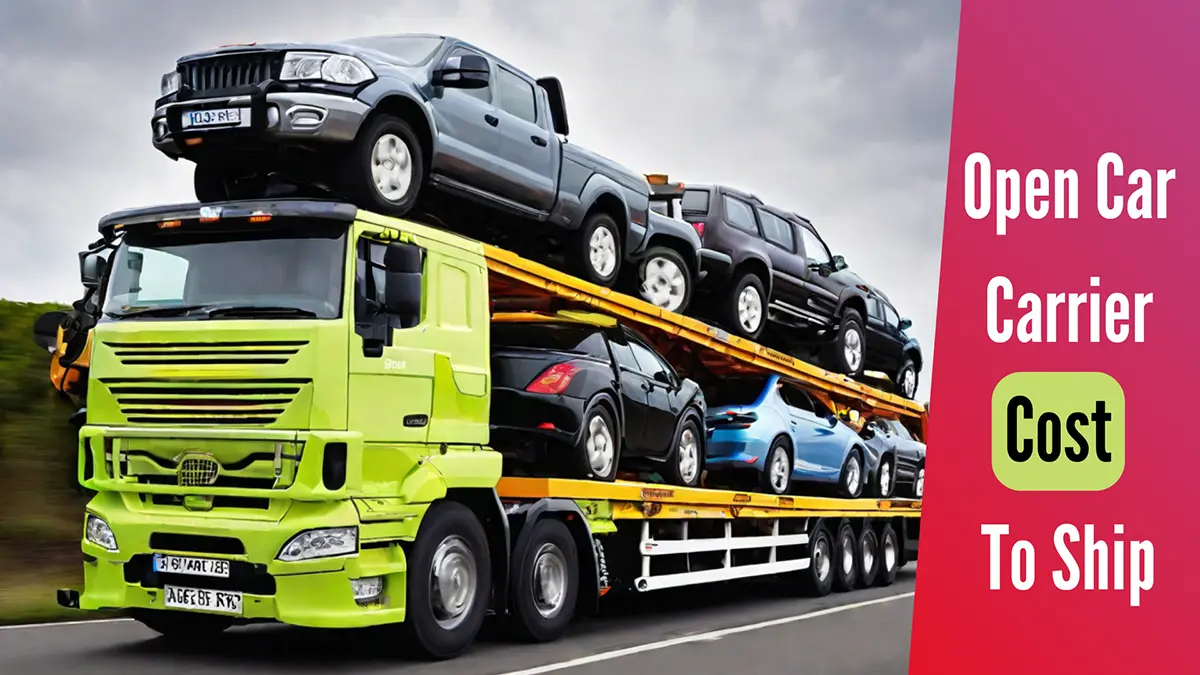When deciding to hire a vehicle transporter, the first question that pops into every automobile owner’s mind is how much it costs to ship a car. Naturally, everyone wants the option that offers the best value for the least money.
An open carrier offers at least 25% less vehicle transport prices than an enclosed carrier, so that’s a good option.
We’ve put together this guide to help you learn how to get quotes for free, how open carrier auto shipping rates are determined, and more. So read on to learn all that:
How to Roughly Calculate Vehicle Shipping Cost?
Determining the cost to ship a car can be straightforward if you have the right tools. In this section, we’ll provide a simple formula and a cost estimator table to help you understand the expected expenses for your car shipping needs.
Car Shipping Cost Estimator Table:
The table below offers a general guideline on the average cost per mile for shipping a vehicle based on the total distance of the transport. Remember that these are rough estimates, as the final cost can change based on various factors like vehicle size, time of year, and additional services required.
| Distance | Base Price Per mile | Example Distance | Example Price |
|---|---|---|---|
| 1-500 Miles | $1.00 | 400 miles | $400 |
| 500+ miles | $0.75 | 900 miles | $675 |
| 1,000+ miles | $0.60 | 1,200 miles | $720 |
| 2,000+ miles | $0.50 | 2,400 miles | $1,200 |
| 2,500+ miles | $0.40 | 3,600 miles | $1,440 |
To use this table, simply identify the distance range that matches your shipment, then multiply the cost per mile by the total miles. If the vehicle is larger than a sedan, like an SUV or truck, add $150 to the quote as well. This will give you a rough estimate of the total cost to ship your car or truck.
For example, if you need to transport a sedan 1,500 miles, the estimated cost would be around $900 (1,500 miles x $0.60 per mile). For a larger SUV over the same distance, the cost would be approximately $1,050 (1,500 miles x $0.6 per mile + $150 for increased weight and dimensions of the SUV).
Remember, these are just general guidelines, and the actual cost can change depending on your specific requirements. It’s always best to get quotes from multiple vehicle transport companies to ensure you get the best deal.
Average Cost To Ship A Car Open vs Enclosed Carriers:
Open car shipping costs will almost always be lower than enclosed shipping mainly because they allow more vehicles to be shipped together (6-9 vs. 5-7), and they are more widely available, saving shippers time and money. Moreover, enclosed carriers offer higher protection, adding to the cost.
That said, the difference between costs can range from 25% to 40% and even more depending on the company you’re working with. To get a better idea of costs, look at this table below from our enclosed shipping cost data:

As per the chart above, an enclosed carrier is at least 25% more expensive than an open carrier. In terms of cost numbers, the difference ranges from $167 to $299, which is not that much if you’re shipping an expensive vehicle worth over $30k.
7 Factors Determining Shipping Cars Cost Using Open-Air Carrier:
The final cost can vary significantly when shipping a car via an open-air carrier based on several key factors. Learning about these variables can help you better estimate vehicle transport prices and plan your budget accordingly.

Distance
The distance your vehicle needs to be hauled is crucial in determining the shipping cost. Generally, the further the pickup and delivery locations are, the higher the overall cost. For example, shipping a car from Los Angeles to New York City will typically cost more than transporting it from Los Angeles to San Francisco.
| Distance | Average Cost per Mile |
|---|---|
| Under 500 miles | $1.00 |
| 500 - 1,500 miles | $0.75 |
| Over 1,500 miles | $0.60 |
Size and Weight of Vehicle
An automobile’s weight and dimensions can also impact the shipping cost. Larger, heavier vehicles typically require more space on the carrier and may incur additional fees. For instance, shipping a compact sedan will generally cost less than transporting a full-size SUV or a heavy-duty truck. Here are some examples for 500 to 1,000 miles:
- Compact cars: $500 - $800
- Midsize cars: $600 - $900
- Pickup trucks: $700 - $1,100
- Full-size SUVs: $800 - $1,200
Ability to Stack Vehicles
Open-air carriers can often stack vehicles on top of each other, reducing the overall cost per vehicle. If your vehicle can be stacked with others, you may be able to take advantage of this cost-saving opportunity.
However, not all vehicles, such as oversized, lifted, or specialty cars, are suitable for stacking. The carrier must allocate more space in these cases, leading to higher transport prices.
Door-to-Door or Terminal-to-Terminal
You can choose between door-to-door and terminal-to-terminal car shipping services. Door-to-door auto shipping, where the carrier picks up and delivers the vehicle directly, is typically more convenient but may cost slightly more.
Terminal-to-terminal service, where you drop off and pick up the vehicle at designated locations, can be more cost-effective. However, your car costs such as fuel, and wear and tear can be high if the terminals are far from the origin and drop locations.
| Service Type | Average Cost 1,000 Miles |
|---|---|
| Door-to-Door | $800 - $1,200 more |
| Terminal-to-Terminal | $700 - $1,000 less |
Terrain and Route Conditions
The transportation path’s terrain and route conditions can also impact the shipping cost. Highways with steep grades, narrow roads, or challenging weather conditions may require the carrier to use specialized equipment or take a longer, alternate route, leading to higher prices.
For example, shipping a car from Los Angeles to San Francisco may cost less than transporting it from Los Angeles to Denver, as the latter route involves navigating through mountainous terrain.
Time of Year
The season can also influence the vehicle shipping quote. During the peak summer and winter months, when demand is higher, transport prices may increase due to the limited availability of carriers and drivers. Conversely, the off-season, typically spring and fall, may offer more favorable rates.
Overwidth/Overweight Permits or Escorts
If your vehicle is oversized or overweight, the carrier may need to obtain special permits or hire escorts to ensure safe transport. These additional requirements can significantly increase the overall cost of shipping your car.
5 Smart Tips to Reduce Open Carrier Vehicle Shipping Costs:
Shipping your car doesn’t have to break the bank. These savvy strategies can help you trim your auto transport costs without sacrificing quality or safety. Let’s explore how to make vehicle shipping more budget-friendly.
Compare rates from multiple carriers.
Don’t settle for the first quote you receive. Get estimates from at least three different auto transport companies.
Use online shipping cost estimators to kickstart your research. Remember, the lowest price isn’t always the best deal - balance cost with reputation and service quality.
Book during the off-season
Timing is crucial in car shipping. Summer months and holidays often see higher prices due to increased demand.
Consider scheduling your vehicle transport during fall or winter for potentially lower rates. For example, shipping a sedan from New York to Florida in January could cost 10-20% less than in July.
Ask For Discounts
Many carriers offer special rates for specific groups. If you’re an AAA member, active military, student, snowbird, or disabled, don’t hesitate to ask about available discounts. Some companies might slash up to 10% off your total vehicle transport prices.
Provide accurate vehicle details upfront.
Be precise about your car’s make, model, condition, and any modifications. Accurate information helps avoid surprise fees later.
For instance, failing to mention a lifted truck could result in a $200-$300 surcharge due to extra space requirements.
Disassemble Non-Essential Parts for Compact Shipping
If your vehicle has removable parts like bike racks or spoilers, consider removing them before shipping. This can reduce your car’s dimensions and potentially lower the cost.
Ensure you inform the carrier about any changes to avoid confusion during pickup.
3 Best Ways to Find Vehicle Transport Prices For Free:
Researching and obtaining free quotes for car shipping can help you thoroughly compare brokers and get an idea of standard rates in the market for better negotiation. Here are three effective methods to find vehicle transport prices right from your couch and for free:
Live Chat
Many vehicle transport companies, like Easy Auto Ship, offer a live chat convenience on their websites, allowing you to have a conversation with a customer service representative in real-time. This interactive platform lets you discuss your specific needs, obtain personalized shipping cost estimates, and ask relevant questions.
| Pros of Live Chat | Cons of Live Chat |
|---|---|
|
|
Phone Call
Contacting car shipping companies by phone is another effective way to obtain free vehicle transport prices. Speaking with a logistics expert allows you to discuss your specific requirements, receive a detailed shipping quote, ask for a breakdown of costs, and negotiate any potential discounts.
| Pros of Phone Calls | Cons of Phone Calls |
|---|---|
|
|
Vehicle Transport Cost Calculator
Many vehicle transport companies offer online car shipping cost estimator tools enabling you to input your specific requirements and receive a free quote. These user-friendly car transport cost calculators consider factors such as vehicle type, pickup and delivery locations, and desired delivery timeframe to provide you with a comprehensive shipping cost estimate. This convenient option lets you compare prices across multiple providers quickly.
| Pros of Vehicle Transport Cost Calculator | Cons of Vehicle Transport Cost Calculator |
|---|---|
|
|
How to Get Free Quotes Using Vehicle Transport Cost Calculator?
Getting free quotes using an auto shipping cost calculator is super simple and hardly takes 2 minutes.
At Easy Auto Ship, we’ve partnered with SuperFlo Systems to develop a state-of-the-art quote estimator with a complex algorithm that considers several factors before sending you a price, including distance, vehicle type, open or enclosed service, gas prices, seasonal demand, and more.
This ensures the calculator gives out prices closer to the final quotation. That said, here are some steps to use our free online cost estimator:
When you visit diytransport.com, you’ll see a cost calculator on the top right corner of the page.
- Please enter all the details in there, including pick-up and drop-off points, vehicle information, an open or enclosed trailer, and some contact information where the quote can be sent with all the details.
- Next, wait a few minutes while our system calculates your quote using the algorithmic data our team has taught it.
- Once you receive the quote, you can call us or use live chat to ask questions or book the service.
That’s how easy it is to get a free, no-obligation auto shipping quote using our free online cost estimator.
Should You Trust the Accuracy of Random Car Shipping Cost Estimators Online?
No, you should not blindly trust these quote calculators because they are developed with some built-in algorithms, and not all of them take real-time data. This means the real quote can be more or less than any quote estimator online. Here’s a further explanation:
- Algorithmic Limitations: Most online estimators use simplified algorithms that don’t account for the complex variables involved in auto transport. They may rely on outdated data or oversimplified formulas that fail to capture the nuances of each unique shipping scenario. This is especially true in the case of international car shipping as fuel costs, regulations, taxes, and fees can change quickly depending on the destination countries. To ensure you are aware of changing maritime scenarios, you need to keep tabs on freight news and developments every few weeks; these calculators cannot do that.
- Lack of Real-Time Data: The auto transport industry is dynamic, with fluctuating prices based on fuel costs, seasonal demand, and route popularity. Many online calculators don’t incorporate real-time data, leading to potentially significant discrepancies between estimates and actual costs.
- Incomplete Factor Consideration: Accurate car shipping quotes depend on numerous factors that basic online tools often overlook, such as:
- Specific pickup and delivery locations (not just cities or zip codes)
- Vehicle make, model, and condition
- Transport type (open vs. enclosed)
- Timeframe flexibility
- Current market conditions
- Marketing Tactics: Some online estimators may intentionally underestimate costs to attract customers, only to surprise them with higher prices later in the booking process.
- Lack of Personalization: Every car shipment is unique, and online calculators can’t account for special requirements or circumstances that might affect pricing.
| Factor | Online Estimator | Reality |
|---|---|---|
| Base Price | Often provides a single-figure | Can vary widely based on carrier availability and route |
| Fuel Surcharge | May use outdated or average fuel prices | Fluctuates with current fuel costs |
| Season | Might not consider seasonal fluctuations | Prices can be significantly higher during peak seasons |
| Vehicle Size | May only offer broad categories | Specific dimensions and weight affect pricing |
| Insurance | Often not included or unclear | Varies based on declared value and coverage options |
| Additional Services | Rarely included | Can add significant costs (e.g., expedited shipping, door-to-door service) |
Easy Auto Ship Offers Free & Accurate Auto Shipping Rates For Your Specific Needs:
The best thing you can do right now if you’re looking to ship your automobile is to pick up your phone and call (888) 687-3243 to speak to our agents. You don’t have to use calculators or comb the internet to find average car shipping costs.
Speak to our agents, tell them your specific requirements, and get an instant quotation without any obligations. You can then ask questions, clarify any confusion, or book the shipping immediately. We’ll be more than happy to hear from you.





